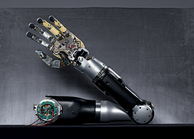What is a prosthetic limb?
A prosthetic limb is an artificial substitute for a missing body part, such as a leg or an arm, eye or tooth used for functional or cosmetic reason. A prosthetic limb may be used if losing a limb in an accident or if limbs have to be amputated due to e.g. medical reasons or illness such as cancer in the eye.
How long have prosthetic limbs existed?
Prosthetic limbs have existed for centuries. Prosthetic care goes back to the fifth Egyptian Dynasty (2750-2625 B.C. The first prosthetic limbs were totally different compared to what they are now. They have evolved from wooden arms with hooks to high tech plastic, fiberglass and metal devices designed to fit limbs amputated at different points.
How do prosthetic limbs work?
Prosthetic limbs used for cosmetic reasons main function is to make a person look more normal and feel like an ordinary person.
Functional prosthetic limbs mainly solve a functional problem such that a person can walk or pick things up or hold a cup. The most modern prosthesis work by wires being connected to your nerves with electrodes that detect electric impulses. Your brain sends electric impulses through the nerves; the electrodes detect this and send them on to a mini computer inside your prosthetic arm. The computer translates the impulses to specific movements and controls the hands actual movement. The movements can be to grab or hold something.
Scientists are making an entirely new type of prosthetic arm and hand that allows a man/woman to get back not only movement, but also the sense of touch., hot and cold
Who makes prosthetic limbs?
Prosthetic limbs are made by specialised companies like the Orthotics and Prosthetics located in the US. This company does not only fabricate them but are also custom fitting the prosthetics. Another company is Virginia Prosthetics, established in 1966, is the largest provider of prosthetic services in Virginia, US. This company is supporting the 2011 Commonwealth Games.
Canada's golden girl Lauren Woolstencroft, 24, won her first Olympic gold medal in alpine skiing at the 2002 Paralympics in Salt Lake City. and fearlessness has led to success on the slopes and even to the 2006 Paralympic Games in Torino, Italy.Even though Lauren took to skis with ease, she originally had no intention of competing. Bored with riding, Lauren quit at age 14. I had actually been a competitive horseback rider before she says,
Canada's Lauren Woolstencroft races in the women's 2010 winter Paralympics games and won five gold medals. She is 28years old and was born missing both legs below the knee and her left arm below the elbow. So she got a prosthetic.
· 1000 B.C.
o In the year 2000, researchers in Cairo/Egypt, strangely what they believe to be the oldest documented artificial body part is a prosthetic toe made of wood and leather. The device(made) found attached to the nearly 3,000year old mummified remains of an Egyptian noblewoman.
· 300B.C
o An artificial limb dating from 300 B.C. was a copper and wood leg unearthed at Capri, Italy in 1858.
· 500B.C.
o The earliest known written reference to an artificial limb was made around 500 B.C. a man called Herodotus wrote of a prisoner who escaped from his chains by cutting off his foot, which he later replaced with a wooden substitute.
· 1529
o French surgery doctor, Ambroise Pare (1510-1590) introduced amputation as a lifesaving measure in medicine. Soon after, Pare started developing prosthetic limbs in a scientific manner.
· 1812
o Upper limbs, developed by Peter Baliff of Berlin 1812 for below-elbow amputees
· 1844
o Van Peetersen in 1844 for above-elbow amputees, were functional, but they were still far less than ideal.
· 1861
o J. E. Hanger, an engineering student, lost his leg in the Civil War. He designed an artificial leg for himself and in 1861 founded a company to manufacture prosthetic legs. The J. E. Hanger Company is still in existence today.
· 1863
o An improvement to the attachment of artificial limbs by fastening a body socket to the limb with atmospheric pressure.
· 1898
o Dr. Vanghetti invented an artificial limb that could move with through muscle contraction
· 1909
· Invented a terminal device to be used in the place of a hand in 1909. Until this invention. They had consisted of a leather socket and a heavy steel frame, and either had a heavy cosmetic hand in a glove, an unfinished mechanical hand, or a passive hook incapable of prehension. Invention of a split hook that was anchored to the opposite shoulder and could be opened with a strap across the back and closed by rubber bands.
· 1946
o A major advancement was made in the attachment of lower limbs. A suction sock for the above-knee prosthesis was created at University of California (UC) at Berkeley
· 1960’s
o Use of electrical signals from the patient's arm muscles to move the limb. Research began in the late 1940s in West Germany, and by the late sixties myoelectric devices were available for adults
· 2000’s
o Computers have been used to help fit amputees with prosthetic limbs. Eighty-five percent of private prosthetic facilities use a CAD/CAM to design a model of the patient's arm or leg, which can be used to prepare a mold to shape the new limb. Laser-guided measuring and fitting is also available.
A prosthetic limb is an artificial substitute for a missing body part, such as a leg or an arm, eye or tooth used for functional or cosmetic reason. A prosthetic limb may be used if losing a limb in an accident or if limbs have to be amputated due to e.g. medical reasons or illness such as cancer in the eye.
How long have prosthetic limbs existed?
Prosthetic limbs have existed for centuries. Prosthetic care goes back to the fifth Egyptian Dynasty (2750-2625 B.C. The first prosthetic limbs were totally different compared to what they are now. They have evolved from wooden arms with hooks to high tech plastic, fiberglass and metal devices designed to fit limbs amputated at different points.
How do prosthetic limbs work?
Prosthetic limbs used for cosmetic reasons main function is to make a person look more normal and feel like an ordinary person.
Functional prosthetic limbs mainly solve a functional problem such that a person can walk or pick things up or hold a cup. The most modern prosthesis work by wires being connected to your nerves with electrodes that detect electric impulses. Your brain sends electric impulses through the nerves; the electrodes detect this and send them on to a mini computer inside your prosthetic arm. The computer translates the impulses to specific movements and controls the hands actual movement. The movements can be to grab or hold something.
Scientists are making an entirely new type of prosthetic arm and hand that allows a man/woman to get back not only movement, but also the sense of touch., hot and cold
Who makes prosthetic limbs?
Prosthetic limbs are made by specialised companies like the Orthotics and Prosthetics located in the US. This company does not only fabricate them but are also custom fitting the prosthetics. Another company is Virginia Prosthetics, established in 1966, is the largest provider of prosthetic services in Virginia, US. This company is supporting the 2011 Commonwealth Games.
Canada's golden girl Lauren Woolstencroft, 24, won her first Olympic gold medal in alpine skiing at the 2002 Paralympics in Salt Lake City. and fearlessness has led to success on the slopes and even to the 2006 Paralympic Games in Torino, Italy.Even though Lauren took to skis with ease, she originally had no intention of competing. Bored with riding, Lauren quit at age 14. I had actually been a competitive horseback rider before she says,
Canada's Lauren Woolstencroft races in the women's 2010 winter Paralympics games and won five gold medals. She is 28years old and was born missing both legs below the knee and her left arm below the elbow. So she got a prosthetic.
· 1000 B.C.
o In the year 2000, researchers in Cairo/Egypt, strangely what they believe to be the oldest documented artificial body part is a prosthetic toe made of wood and leather. The device(made) found attached to the nearly 3,000year old mummified remains of an Egyptian noblewoman.
· 300B.C
o An artificial limb dating from 300 B.C. was a copper and wood leg unearthed at Capri, Italy in 1858.
· 500B.C.
o The earliest known written reference to an artificial limb was made around 500 B.C. a man called Herodotus wrote of a prisoner who escaped from his chains by cutting off his foot, which he later replaced with a wooden substitute.
· 1529
o French surgery doctor, Ambroise Pare (1510-1590) introduced amputation as a lifesaving measure in medicine. Soon after, Pare started developing prosthetic limbs in a scientific manner.
· 1812
o Upper limbs, developed by Peter Baliff of Berlin 1812 for below-elbow amputees
· 1844
o Van Peetersen in 1844 for above-elbow amputees, were functional, but they were still far less than ideal.
· 1861
o J. E. Hanger, an engineering student, lost his leg in the Civil War. He designed an artificial leg for himself and in 1861 founded a company to manufacture prosthetic legs. The J. E. Hanger Company is still in existence today.
· 1863
o An improvement to the attachment of artificial limbs by fastening a body socket to the limb with atmospheric pressure.
· 1898
o Dr. Vanghetti invented an artificial limb that could move with through muscle contraction
· 1909
· Invented a terminal device to be used in the place of a hand in 1909. Until this invention. They had consisted of a leather socket and a heavy steel frame, and either had a heavy cosmetic hand in a glove, an unfinished mechanical hand, or a passive hook incapable of prehension. Invention of a split hook that was anchored to the opposite shoulder and could be opened with a strap across the back and closed by rubber bands.
· 1946
o A major advancement was made in the attachment of lower limbs. A suction sock for the above-knee prosthesis was created at University of California (UC) at Berkeley
· 1960’s
o Use of electrical signals from the patient's arm muscles to move the limb. Research began in the late 1940s in West Germany, and by the late sixties myoelectric devices were available for adults
· 2000’s
o Computers have been used to help fit amputees with prosthetic limbs. Eighty-five percent of private prosthetic facilities use a CAD/CAM to design a model of the patient's arm or leg, which can be used to prepare a mold to shape the new limb. Laser-guided measuring and fitting is also available.


